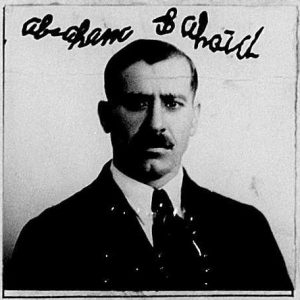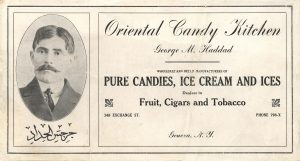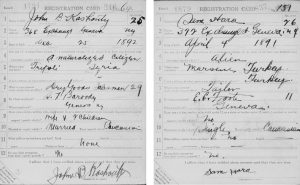Visiting the Syrian Community in Glenwood Cemetery
By Becky Chapin, Archivist
During my research into the local Syrian community, I spoke with Father Murphy at St. Michael’s Orthodox Church. I learned so much through that conversation and my follow-up research about why there were many Syrians immigrating during certain times that I wanted to add an introduction at the beginning of this year’s Glenwood Cemetery tour about those circumstances.
The Syrian community first arrived in Geneva in the 1890s from the regions of Metoon-Arnuuk, Melke, Bamlake, or Bizek (according to St. Michael’s 40th-anniversary publication). Many were trying to escape the 1895-1896 massacres in Turkey that affected the Armenian and Syriac Orthodox communities; an estimated 105,000 Christians were killed. Then again, when the Russian Revolution occurred in 1917, over 300 Orthodox persons were executed by the regime, and the Patriarchate of Jerusalem went from bad to worse as it had long been dependent on Russian financial support.
World War I also intensified ethnic cleansing, and the area of Syria where many members of our Syrian community are from was especially hard hit because it was very Christian, and Muslims came through that area killing Christians. A tumultuous period from 1916 through the 1920s led to instability in the Syrian Orthodox religion at its core that affected congregations throughout the world and even St Michael’s here in Geneva. Some 8,000 Orthodox Christians were estimated to have been killed in 1922 alone. In 1923, a population exchange between Greece and Turkey occurred where thousands upon thousands of Orthodox Christians were forced to abandon their homeland in Turkey and move to Greece, while Muslims in Greece would be deported to Turkey.
Early immigrants to our area were devoted to their faith. Saliba Baroody offered his home to Syrian immigrants in Geneva who wished to gather for services. The first Syrian wedding in Geneva was in 1906 at St Peter’s which has a close relationship with their neighbor church even today. Eventually, many of the families would contribute their time, resources, and labor to construct St Michael’s Syrian Orthodox Church on Geneva Street which was completed in 1915.

A few photos of Syrians from our community were found in naturalization paperwork after 1930. Photo of Abraham Sahaid.
Problems plagued the congregation in parallel to the overall Church when the congregation split into two factions in 1918 and caused the closure of the church. Again in 1926, two factions split the congregation when one group desired a pastor under the jurisdiction of an American bishop named by a national group, while another faction wanted to keep Reverend Daniel George (their first priest) under the jurisdiction of the patriarch of the Antioch. The resulting differences played out in 1927, when multiple parishioners started a fight outside the church, and a man named Norman Joseph started to build a fire in the church only to be attacked by someone.
The church building was sold to the city in the 1950s, and the current church was completed on Genesee Street in 1961, where it is now known as St Michael’s Orthodox Church.
I had so much information on families that we only got through section 19 in the hour we had on October 9, leaving me with the possibility of doing a part 2 in 2023. Some notable visits we made in section 19 are below.
Saliba Baroody immigrated to America in 1895, with his wife Martha Moses following a few years later. Their first child, Louise, was born in Syria in 1894, while their second child Thomas was born in Fort Plain, New York in 1900. They were only briefly in Fort Plain before the family moved, as they were captured in the 1900 census in Geneva with various family members. Like many other Syrians at the time, Saliba started as a peddler but was able to open his own dry goods business around 1906. He operated out of 358-360 Exchange Street for many years before moving to 370 Exchange. His son Thomas worked with him, eventually moving the business to 372 Exchange as a cigar store, where today you can see ST Baroody at the top of the building.

George Haddad owned a candy store on Exchange Street. His advertising card featured his picture with Arabic letters.
Julia Baroody Simon came to America at 15 years old with her mother Susan Jacobs Baroody and three siblings, to join her father Norman T Baroody, Saliba’s younger brother. Three more siblings arrived in Geneva in the years following. Norman and Susan arranged a marriage for Julia to Michael Simon, who was from their hometown in Syria. Michael was working a few manufacturing jobs including at Lisk Manufacturing. In 1925, he had four fingers on his right hand amputated in a machine accident. After receiving his compensation, Michael and Julia bought a house on Exchange Street where they lived in one portion and operated a retail grocery business in the other portion.
Mary Gebara immigrated to America around 1911. Two of her children, Leo and Jennie, immigrated to America on their own, while her third child, Sara, remained in Syria. Mary’s story is interesting but incomplete. The 1930 census shows her living with Jennie’s family and lists her as divorced. As you can imagine, this was incredibly unusual for the time. The 1940 census then shows Mary living with Leo but her marriage status was widowed. To add another puzzle piece, Francis Norman’s obituary lists Leo and Jennie as his step siblings, so it seems that Mary did remarry at some point though I was unable to identify who. In her obituary she is identified as Mary Gebara, though she appears in other records as Mary Gebara Norman. So, this was a mystery I couldn’t solve.
Charles Habib Leo was born in Syria in 1880. He traveled to America via France in 1903 with help from Saliba Baroody and George Haddad, a candy maker. His wife Mary followed around 1906. They had 3 children, Sadie, Edward, and Charles Abraham. The directories show Charles and Charles often went by their middle names. Charles Sr worked at the stove works, for a nursery, and for the Lehigh Valley Railroad. He passed in 1959. A year later, his wife Mary Essa Leo died. By then, Charles and Mary had lived in Geneva for over 50 years.

Many of the early Syrian immigrants were drafted into World War I as aliens or naturalized citizens. The registration cards and censuses reveal the issues with country boundaries when Syria was considered Lebanon, Turkey, or Syria. Draft registration cards for John Kashouty and Sam Hara.
Charles Hessney came to the United States from Syria at age 13 and lived in Canandaigua where he worked as a peddler. Eventually he was able to get a job at Lisk Manufacturing. At some point, Charles mentioned to a friend that he was looking for a wife. That friend recommended his sister Mary who was 16, and whom the family was trying to get out of Syria. Charles, by then a naturalized citizen, traveled to France to meet Mary so they could be married, and she could come into America as a citizen. Charles gave Mary the option of paying her return passage to Syria if she didn’t like him and that convinced Mary to go ahead and marry him. They were married by a Roman Catholic priest in Marseilles and traveled to Canandaigua, eventually coming to Geneva after Lisk opened a plant on Lehigh Street.

Thank you Becky for the interesting history of the early immigrants from Syria to Geneva and to find the names of those families still here in our community,
It is sad that those religious wars are still going on in different part of the world and people are fleeing from being killed.
Mary Gebara was my grandmother. She lived with us on Grove Street until her repose. You have some of her story right, but not all.
Thank you for your comment. If you have more you would like to share with us, please reach out to Becky at archivisit@historicgeneva.org so that she can update the information in our files.
George Haddad was my great great great Grandfather. My mother still has his copper pot he brought from Syria to make candy in. He came from Bamleke
Wow! It’s amazing you still have the copper pot, what a great connection to your ancestor’s story!